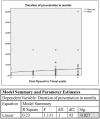Reviving the lost art of scleral buckling surgery for rhegmatogenous retinal detachment: evaluation of risk factors of detachments, poor physiological outcomes, and perspective from a developing country
- PMID: 31001604
- PMCID: PMC6454650
- DOI: 10.1177/2515841419838662
Reviving the lost art of scleral buckling surgery for rhegmatogenous retinal detachment: evaluation of risk factors of detachments, poor physiological outcomes, and perspective from a developing country
Abstract
Purpose: To evaluate the primary anatomic and physiological success of scleral buckling surgery for rhegmatogenous retinal detachment and factors influencing its outcomes.
Methods: This is a prospective analytical study of 92 eyes that underwent scleral buckling at the Lumbini Eye Institute and Research Center, in Lumbini, Nepal. Parameters evaluated which could influence the outcome of the surgery included the lens status, duration of symptoms, locations of breaks, the extent of retinal detachment, and preoperative proliferative vitreoretinopathy.
Results: A total of 92 eyes from 88 patients with rhegmatogenous retinal detachment were evaluated; 68 (74%) eyes were of male and 24 (26%) were of female. The mean time of presentation was 4.71 ± 8.45 months. The overall primary anatomical and physiological success was achieved in 79 (84.9%) and 68 (73.9%) of the cases at 6 months. Sixteen cases developed re-detachment (mean duration of 2.8 ± 1.8 months). Eleven of the cases had a successful anatomical outcome and five of the patients had persistent detachment despite second surgery. In phakic patients, the primary success rate was 92.7% whereas in pseudophakic it was 71.4%. Proliferative vitreoretinopathy 10 (63%) was the most common cause of surgical failure. Bilateral buckling at the same setting was done to two patients-both achieving primary success.
Conclusion: Scleral buckling is a very good surgical option for rhegmatogenous retinal detachment and represents a surgical technique worth being trained, performed, practiced, and continued despite advancements in modern vitreoretinal surgical devices and preference for vitrectomy and tamponade agents. It may also be successfully tried in cases of bilateral rhegmatogenous retinal detachment if a doubt regarding compliance for follow-up and surgery for the fellow eye exists.
Keywords: anatomical success; bilateral; failure risks; phakic; physiological success; pseudophakic; retinal detachment; scleral buckle; visual outcome.
Conflict of interest statement
Conflict of interest statement: The authors declared no potential conflicts of interest with respect to the research, authorship, and/or publication of this article.
Figures
Similar articles
-
Anatomic success of scleral buckling for rhegmatogenous retinal detachment--a retrospective study of 524 cases.Ophthalmologica. 2010;224(5):312-8. doi: 10.1159/000298752. Epub 2010 Mar 23. Ophthalmologica. 2010. PMID: 20332656
-
Anatomical and Visual Outcomes of Scleral Buckling Surgery in Rhegmatogenous Retinal Detachment.Middle East Afr J Ophthalmol. 2020 Jul 20;27(2):100-104. doi: 10.4103/meajo.MEAJO_94_18. eCollection 2020 Apr-Jun. Middle East Afr J Ophthalmol. 2020. PMID: 32874042 Free PMC article.
-
Scleral buckling versus primary vitrectomy in rhegmatogenous retinal detachment: a prospective randomized multicenter clinical study.Ophthalmology. 2007 Dec;114(12):2142-54. doi: 10.1016/j.ophtha.2007.09.013. Ophthalmology. 2007. PMID: 18054633 Clinical Trial.
-
Pars plana vitrectomy versus scleral buckling for repairing simple rhegmatogenous retinal detachments.Cochrane Database Syst Rev. 2019 Mar 8;3(3):CD009562. doi: 10.1002/14651858.CD009562.pub2. Cochrane Database Syst Rev. 2019. PMID: 30848830 Free PMC article.
-
[Primary pars plana vitrectomy. Techniques, indications, and results].Ophthalmologe. 2008 Jan;105(1):19-26. doi: 10.1007/s00347-007-1672-0. Ophthalmologe. 2008. PMID: 18210121 Review. German.
References
-
- Ware J. Surgical observations relative to the eye. 2nd ed. London: J. Mawman, 1805.
-
- Wardrop J. Essays on the morbid anatomy of the human eye. Edinburgh: Archibald Constable, 1818.
-
- Ware J. Chirurgical observations relative to the eye, vol. 2 2nd ed. London: J. Mawman, 1805.
-
- Rucker CW. A history of the ophthalmoscope. Rochester, MN: Whiting Printers, 1971.
LinkOut - more resources
Full Text Sources


